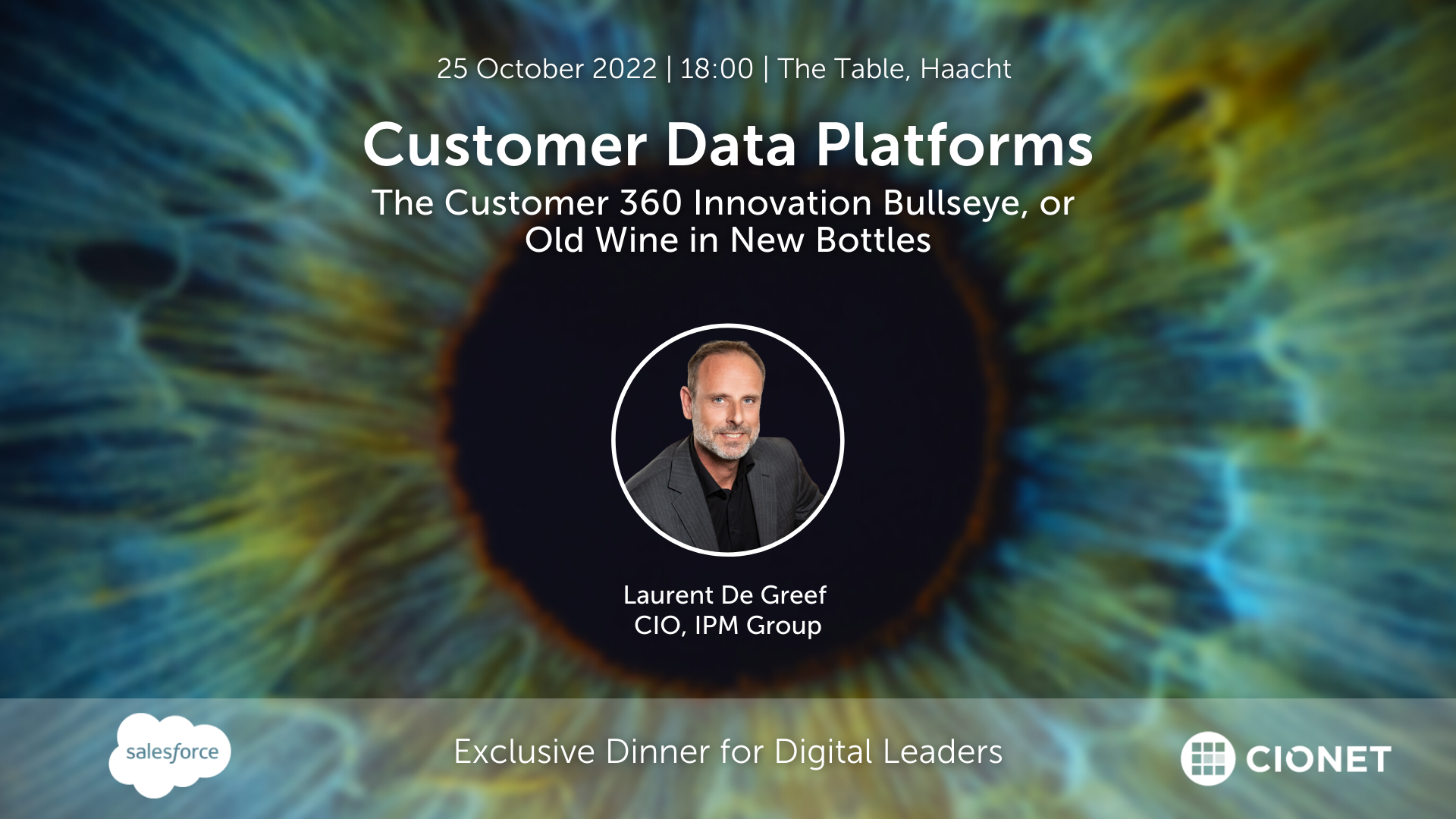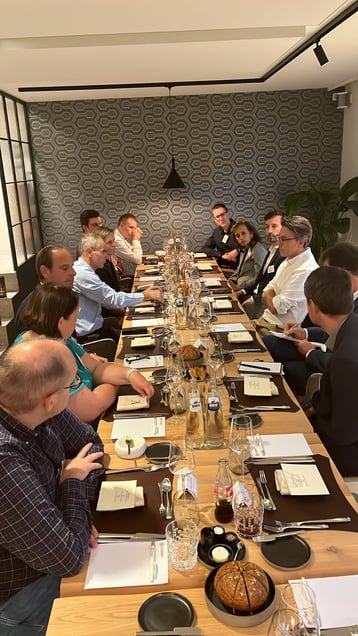.png)
Laurent De Greef , CIO of the IPM Group, and Marijke De Jonckheer, responsible for onboarding and customer data, at ING Belgium were the special invitees to kick off the roundtable on the theme "Customer Data Platforms", set up by CIONET and Salesforce. The place of appointment was "The Table", a stylish restaurant in Boortmeerbeek, near Haacht. Around the table: a dozen CIOs and CDOs from various sectors such as industry, social services, NMBS, and energy.

Data is the raison d'être of a media company
"As for all media companies, data has become the core of our business model", confirmed Laurent De Greef, CIO of the IPM Group, the media group that comprises newspapers such as La Dernière Heure, La Libre Belgique, Paris Match and other papers and more recently, news channel LN24. "Customer intelligence is essential. On the one hand, to drive sales of newspapers and magazines. On the other, to feed the mechanism of the advertising market, where the price of ads is determined by the extent to which segmentation and profiling of target groups are possible. The online ad market operates as a marketplace where advertisers pay for access to specific audiences. Today, the press is facing evolutions that pose significant challenges to this revenue model: firstly, there is the advent of GDPR and other privacy regulations, and secondly, working with "cookies" will soon be a thing of the past. Moreover, global social media and big-tech groups strongly dominate those online advertising markets."
 Ideally, a newspaper knows what the reader is interested in and who he/she is. The first element is to guide the selection of news and other articles offered to the reader to avoid churn and build loyalty with his newspaper. The second element is needed to profile him or her commercially so that the right ads with the right content are offered to the right people according to their interests and resources. In that context, Laurent was faced with the challenge of building a platform to come up to multiple challenges: cover the 'old' CRM functionalities, answer the demand for marketing automation and provide the advertising platform with the necessary data. The IPM Group eventually set up a DMP platform where the 1st party data (data provided to them by the customers themselves), 2nd party data (data about the customers through other parties working with those customers) and 3rd party data (purchased data) are processed and used to enable cookieless - retargeting of customers. The system was built gradually and is in production for most of their newspapers, albeit in separate domains. When asked what the major challenges in setting up these customer intelligence systems were, Laurent referred in particular to drawing out the new data models and the semantic discussions that often occur when defining basic concepts and selecting the information to be collected and processed. "What is a customer?" is apparently not always a simple question. According to Laurent, they followed an iterative process with a mixed squad involving marketing, IT and the editorial team.
Ideally, a newspaper knows what the reader is interested in and who he/she is. The first element is to guide the selection of news and other articles offered to the reader to avoid churn and build loyalty with his newspaper. The second element is needed to profile him or her commercially so that the right ads with the right content are offered to the right people according to their interests and resources. In that context, Laurent was faced with the challenge of building a platform to come up to multiple challenges: cover the 'old' CRM functionalities, answer the demand for marketing automation and provide the advertising platform with the necessary data. The IPM Group eventually set up a DMP platform where the 1st party data (data provided to them by the customers themselves), 2nd party data (data about the customers through other parties working with those customers) and 3rd party data (purchased data) are processed and used to enable cookieless - retargeting of customers. The system was built gradually and is in production for most of their newspapers, albeit in separate domains. When asked what the major challenges in setting up these customer intelligence systems were, Laurent referred in particular to drawing out the new data models and the semantic discussions that often occur when defining basic concepts and selecting the information to be collected and processed. "What is a customer?" is apparently not always a simple question. According to Laurent, they followed an iterative process with a mixed squad involving marketing, IT and the editorial team.
The bank: a different business model but equally data-driven
The first thing Marijke pointed out is that the role and place of data in their business model are very different from a media group like the IPM Group. Like the media, banks also face almost complete digitisation of their services. Real-life interactions between the bank and its customers are still decreasing in favour of the digital variant. Moreover, as a bank - and certainly as a systemic bank - they are subject to many laws and regulations that oblige them to know their customers. The objective is always to protect the customer's interest and society, for instance, by correctly assessing the customer's financial capacity and risk awareness when taking out a loan or setting up an investment portfolio. According to Marijke, the first step towards centralised customer data
management was creating a single repository (data lake). Data were enriched with the information
captured through the websites. Another source is, of course, transactional data. In fact, data
abounds in a bank. The future CDP's functionalities were built incrementally, starting with reporting before moving on to processing and using the data for marketing purposes. But, Marijke stresses, customer consent remains indispensable. Today, the CDP is part of the bank's DNA and has become an essential tool in making the bank a data-driven organisation.
Who is leading the dance?
The entire gathering unanimously agreed that setting up a customer data (CDP) programme requires a multi-disciplinary approach, but one in which everyone has a clearly defined mission. Leave the data modelling work to the data scientists. But ensure the creation of an exemplary data catalogue, data ambassadors and training that teaches business staff the importance and significance of the data programme. As rightly noted at the table, ideally, you create a data platform that is so intuitive that business users work with it without having to worry about the technological solutions behind it. Still, even a particularly (business) user-friendly system is no guarantee for effective usage unless clear KPIs are to be measured and realised that require recourse to the available data.
Practice shows that in some companies, IT is still the driving force of the CDP implementation,
outlining the roadmap and selecting the domains or use cases in which to invest. This is avoidable,
even according to the CIO involved, unless there is a perfectly reasoned alignment with the business that identifies their needs. In fact, it boils down to a change process, a learning process in which the whole company has to be involved in making the steps from a data-informed to a data-driven organisation. Such a transformation quickly encounters resistance, such as from business or
salespeople who have to accept that it is not always they who know best what is good for the
customer or what the customer wants, and that a data-driven system can assist or guide them in
these matters. In that context, it was suggested to apply the principle of A B testing, where the A
scenario is driven by the sales team and the B scenario is drawn out by the system. Looking at the
results of both scenarios will certainly make it easier to take the right decisions.
 The roundtable discussion clearly showed that there were at least six different customer data projects in the gathering, admittedly at different stages, but each with the ultimate goal of building a 360 view of the customers. At the same time, it became clear that the specific context of the organisation strongly influences the set-up of a customer data platform; starting with whether you work in a B2B or B2C context, next to external factors such as the privacy and specific regulatory framework in which you work - re the social service groups and banks around the table - or your
The roundtable discussion clearly showed that there were at least six different customer data projects in the gathering, admittedly at different stages, but each with the ultimate goal of building a 360 view of the customers. At the same time, it became clear that the specific context of the organisation strongly influences the set-up of a customer data platform; starting with whether you work in a B2B or B2C context, next to external factors such as the privacy and specific regulatory framework in which you work - re the social service groups and banks around the table - or your
commercial or logistical model. If you do not really know who your decision takers are, as is the case, for example, for a company like Terumo that sells medical devices directly and indirectly through different channels, segmentation and customer profiling become particularly challenging.
Monitoring and measuring the progress and the results of the CDP project should be foreseen from the start of your CDP programme, if only to justify the ROI of your investments in time, money and expertise to your management. According to the participants, however, the real bottleneck for setting up and rolling out a successful CDP programme is not a technological or financial issue but rather a people issue. It is crucial to work in incremental steps where the whole organisation learns to handle data correctly. Start with the basics, establish clear data catalogues, underline the importance of data quality, work on solid data models and ensure the added value of working with the data becomes visible to everyone. Based on a solid CDP, customer knowledge can be optimised, and, ideally, so can the services provided to the customer. The results then take little time to appear.
These Stories on CIONET Belgium
No Comments Yet
Let us know what you think